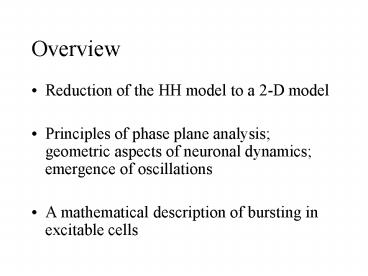Overview - PowerPoint PPT Presentation
Title:
Overview
Description:
Overview Reduction of the HH model to a 2-D model Principles of phase plane analysis; geometric aspects of neuronal dynamics; emergence of oscillations – PowerPoint PPT presentation
Number of Views:68
Avg rating:3.0/5.0
Title: Overview
1
Overview
- Reduction of the HH model to a 2-D model
- Principles of phase plane analysis geometric
aspects of neuronal dynamics emergence of
oscillations - A mathematical description of bursting in
excitable cells
2
HH model
Threshold behaviour
V(0)5 mV
V(0)4 mV
3
(No Transcript)
4
The slow variables h, n
5
Two qualitative observations
- 1) the time scale of the dynamics of the gating
variable m is much faster than that of the
variables n, h. - 2) the time constants and
are roughly the same, whatever the voltage V.
Moreover, the asymptotic functions - ,
- are similar.
6
The idea
use quasi steady-state approximation
- 1)
- 2) lump together the slow variables
7
The V-equation can be rewritten as
or
which must be coupled to the equation for the
recovery variable w,
8
Two dimensional models of excitable media
fast variable
slow variable
Fitzhugh Nagumo
9
2D models
- Phase plane, trajectories
- Vector fields, nullclines
- Fixed points, stability, linearization
- Periodic orbits, limit cycles
- Bifurcations
10
Phase-plane
integration of dynamical equations
the infinitesimal displacement is in the
direction of the flow
11
w- nullcline
V- nullcline
fixed point both the components vanish
12
Stability of fixed points
Introduce the displacement from the F.P.
Linearize the system at the F.P.
Find the eigenvalues of the matrix
and eigenvector
13
An example of bifurcation
saddle-node bifurcation
14
Hopf bifurcation
15
Homoclinic bifurcation
16
The Morris-Lecar model
17
A spike in the ML (type II) model
graded threshold
18
Phase-portrait of the ML (type II) model
19
ML (type II) bifurcation diagram
amplitude of oscillations
The rest state turns unstable here, via a
(subcritical) Hopf bifurcation
20
ML (type II) response function narrow frequency
range
onset of oscillation with non-zero frequency
21
Bistability in ML (type II) model
R
UPO Unstable periodic orbit SPO Stable
periodic orbit R Stable rest state
22
A bistable cell model can switch from rest to
oscilation and then back to rest
23
ML (type I)
U
T
R
unstable manifold
stable manifold
R stable rest state T saddle point
threshold U unstable node
24
ML (type I) threshold behaviour
-20
-22.1
The model shows a distinct threshold
-22.2
-25
25
When the stimulus increases, the stable and the
threshold points coalesce, and a zero-frequency
limit cycle is formed
narrow channel slow dynamics
26
Low frequency repetitive firing
27
ML (type I) bifurcation diagram
high-voltage stable state
unstable oscillations
unstable states
stable oscilllations
a stable rest state exists here
28
ML (type I) response function
Oscillations arise with zero frequency
29
Bursting cells
- Widespread among neurons and non-neuronal cells
- Involved in generation of rythmic pattern (e.g.
breathing, pacemaking, hormone secretion .. ) - The membrane is switching periodically between an
active state (rapid oscillations) and a rest
state (lack of oscillations)
Active phase
Silent phase
30
Bursting with bistability the hystheresis loop
Busting requires more than two dynamical variables
31
- Ca2 is the fundamental second messenger
release - of hormones and neurotransmitters, cell motility
or - contractions, gene expression and development, .
- Ca2 ions flow into the cell via V-dependent
channels - Ca2 is highly buffered inside the cytoplasm,
- low intracellular concentration
phenomenological model
buffering
influx
32
Ca2 controls the activation of ionic channels
adaptation
33
Calcium dynamics provide a slow, negative
feedback on membrane excitability
34
A dynamical interpretation
35
Bursting without bistability
- Without the hystheresis loop, a negative feedback
would only produce adaptation - In order to push the system into the oscillatory
regime, we need a positive feedback, e.g. a
slowly activating Ca2 current
slow time scale
36
Bursting without bistability

